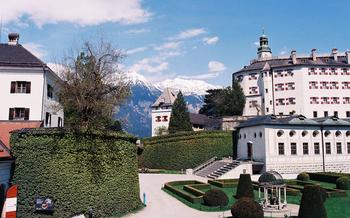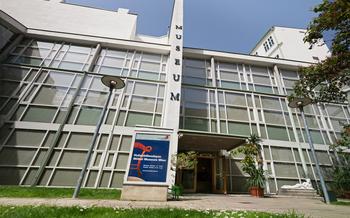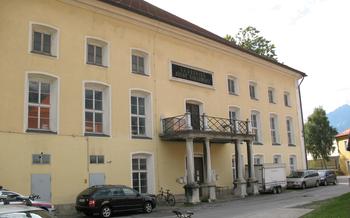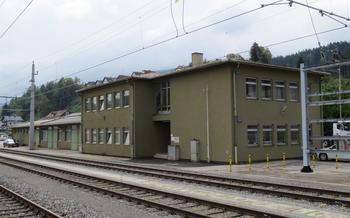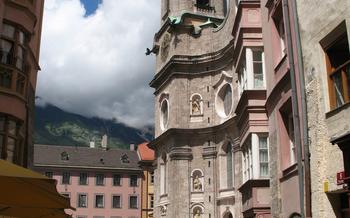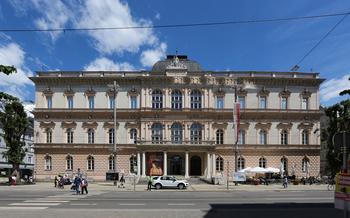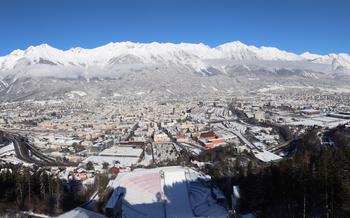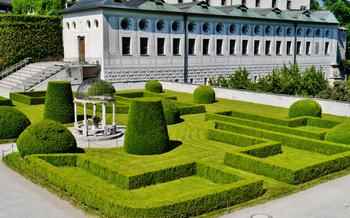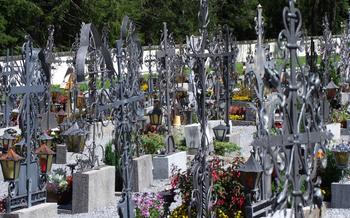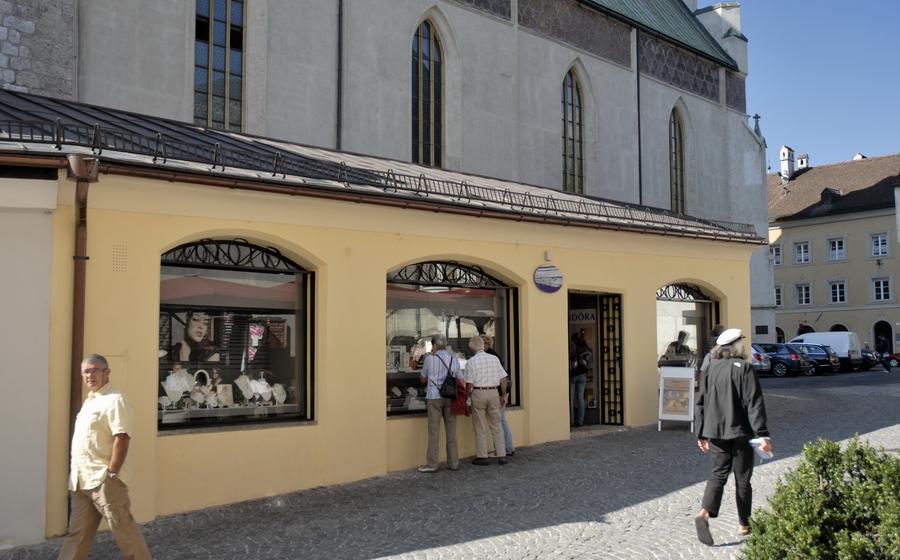
Museum of Medical History at the University of Innsbruck
- History of the Museum:
- Location
- Permanent Exhibitions
- Special Exhibitions
- Guided Tours
- Educational Programs
- Research Facilities
- Museum Shop
- Accessibility
- Admission and Fees:
- Hours of Operation:
- Transportation:
- Food and Drinks
- Photography and Filming
- Insider Tip
History of the Museum:
The Museum of Medical History at the University of Innsbruck, Austria, is a rich repository of medical artifacts and knowledge. Founded in 1905, it stands as a testament to the region's significant medical heritage. The brainchild of Professor Dr. Hermann Schloffer, a renowned surgeon and medical historian, the museum initially displayed his personal collection of medical instruments, books, and anatomical specimens. Over the years, the collection grew through generous donations and acquisitions, solidifying the museum's stature as a leading center for the study of medical history.
The museum's collection is a diverse and fascinating mix of objects, ranging from ancient surgical tools to modern medical equipment. Rare books, manuscripts, and historic documents provide insights into the evolution of medical knowledge, while exhibits on the history of surgery, pharmacology, and dentistry offer a glimpse into the challenges and triumphs of medical professionals throughout the ages.
What sets the Museum of Medical History apart is its focus on the human aspect of medicine. Personal accounts, medical instruments, and poignant stories bring to life the struggles, triumphs, and advancements in medical care. The museum serves as a reminder that behind every medical discovery or breakthrough lies the dedication, compassion, and relentless pursuit of knowledge by countless individuals who have dedicated their lives to the field of medicine.
Location
The Museum of Medical History, a treasure trove of medical knowledge and artifacts, is conveniently located at Innrain 52, 6020 Innsbruck, Austria. Situated in the heart of the historic city of Innsbruck, the museum is easily accessible by foot, public transportation, or car. The nearby landmarks include the scenic River Inn, the majestic Hofburg Palace, and the vibrant Old Town, known for its medieval charm. These iconic landmarks provide a picturesque backdrop to the museum's location, making it a must-visit destination for history, culture, and medical enthusiasts.
Permanent Exhibitions
The Museum of Medical History at the University of Innsbruck boasts a diverse collection of permanent exhibitions that delve into various aspects of medicine and healthcare. These exhibitions showcase a fascinating journey through medical advancements, discoveries, and innovations that have shaped our understanding of human health.
-
"From Bloodletting to Antibiotics: The Evolution of Medical Treatment" This exhibition traces the transformation of medical practices from ancient bloodletting techniques to the development of modern antibiotics. Visitors can explore interactive displays, historical tools, and medical artifacts that illustrate the evolution of disease treatment and the fight against infection.
-
"The Human Body: A Masterpiece of Nature" This exhibition takes visitors on an anatomical journey, showcasing the wonders of the human body and its intricate systems. Through detailed models, interactive exhibits, and medical illustrations, visitors can learn about organ functions, the nervous system, and the amazing resilience of the human organism.
-
"Medical Instruments and Devices: From Stethoscopes to Microscopes" This exhibition displays a collection of medical instruments and devices that have revolutionized healthcare over the centuries. Visitors can marvel at the evolution of stethoscopes, microscopes, X-ray machines, and other diagnostic tools that have aided in the diagnosis and treatment of diseases.
Special Exhibitions
The Museum of Medical History at the University of Innsbruck regularly hosts special or temporary exhibitions alongside its permanent displays. These exhibitions delve into specific themes or topics related to medical history, offering visitors a deeper exploration of various aspects of the field.
The frequency and duration of these special exhibitions vary, with some running for a few weeks or months and others lasting for an entire year. Each exhibition is carefully curated to showcase artifacts, documents, and interactive displays that provide a unique perspective on medical history.
Past special exhibitions have covered a wide range of topics, including the history of surgery, the development of medical instruments, and the role of women in medicine. For example, one notable exhibition explored the fascinating world of ancient Egyptian medicine, showcasing artifacts such as mummies, medical papyri, and tools used by ancient healers.
These special exhibitions not only provide an opportunity for visitors to learn about specific aspects of medical history but also encourage them to think critically about the evolution of medical practices and their impact on society.
Guided Tours
The Museum of Medical History offers guided tours for visitors who seek a deeper understanding of the exhibits and their significance. These tours are led by knowledgeable and passionate guides who provide insights and anecdotes that bring the medical history to life. Visitors can choose from a variety of tour options, including general overviews, thematic explorations, or customized tours tailored to specific interests.
Booking a guided tour in advance is highly recommended, especially for groups or those visiting during peak tourist season. Reservations can be made online through the museum's website or by contacting the museum directly. The tours typically last for about an hour and are available in several languages, including English, German, and Italian.
During the guided tour, visitors will gain a deeper appreciation for the museum's collection. The guides will explain the historical context of the exhibits, share stories about the individuals behind the medical advancements, and demonstrate the use of historical medical instruments. Visitors will also have the opportunity to ask questions and engage in discussions with the guides, making the tour a truly interactive and educational experience.
Educational Programs
The Museum of Medical History is not just a repository of artifacts; it's also a hub for education and outreach. The museum offers a range of educational programs designed to engage and inform visitors of all ages. These programs aim to foster a deeper understanding of medical history, its impact on society, and its relevance to our present-day healthcare practices.
Workshops and lectures are a cornerstone of the museum's educational initiatives. These events feature renowned experts in various fields of medicine and medical history, who share their knowledge and insights with participants. Workshops often focus on hands-on activities, allowing attendees to engage with historical instruments and techniques, while lectures provide in-depth explorations of specific medical topics.
The museum also offers educational programs tailored specifically for school groups. These programs are designed to align with school curricula and provide an immersive learning experience for students. Guided tours, interactive exhibits, and hands-on activities help bring medical history to life for young learners, sparking their curiosity and encouraging them to explore further.
By offering these educational programs, the Museum of Medical History fulfills its mission of promoting knowledge and understanding of the history of medicine. These programs cater to diverse audiences, from students and educators to healthcare professionals and the general public, ensuring that the legacy of medical history continues to inspire and inform future generations.
Research Facilities
The Museum of Medical History is not just a place to appreciate the past; it also serves as a vibrant center for medical history research. Scholars and researchers from around the world are drawn to the museum's extensive collection and resources. The museum houses a comprehensive library specializing in medical history, containing rare books, manuscripts, and journals that provide valuable insights into the evolution of medicine and healthcare.
In addition to the library, the museum also maintains an archive that preserves a wealth of historical documents, photographs, and artifacts. These archival materials offer researchers a unique glimpse into the lives and practices of medical professionals throughout history. The museum's research facilities are open to qualified researchers, providing them with access to these valuable resources to conduct their studies and contribute to the field of medical history.
Museum Shop
Within the Museum of Medical History, visitors will find a well-stocked museum shop that offers a diverse range of souvenirs, books, and medical-related items. Here, visitors can browse and purchase unique mementos of their visit or find specialized medical literature and educational resources. The shop offers an array of souvenirs, from postcards and magnets featuring historical medical illustrations to replicas of antique medical instruments. For those seeking a deeper dive into medical history, the shop carries an extensive selection of books, including historical texts, biographies of renowned physicians, and contemporary works on medical ethics and advancements. Additionally, the shop caters to the needs of medical professionals and students by offering specialized medical supplies, such as stethoscopes, surgical instruments, and anatomical models. The museum shop is conveniently located within the museum premises, providing visitors with the opportunity to browse and shop at their leisure. Its operating hours mirror those of the museum, ensuring that visitors have ample time to explore both the exhibitions and the shop during their visit.
Accessibility
The Museum of Medical History is committed to providing an accessible and inclusive environment for all visitors. The museum features a variety of accessibility features to ensure that everyone can enjoy and benefit from its exhibits and programs.
Wheelchair users and visitors with limited mobility can easily navigate the museum's spacious galleries and corridors. Ramps and elevators are available to access all levels of the museum, and accessible restrooms are conveniently located throughout the building.
For visitors with visual impairments, the museum offers audio guides that provide detailed descriptions of the exhibits. Braille signage is also available to assist visitors in exploring the museum independently.
The museum staff is always happy to provide assistance to visitors with disabilities. They can help with directions, provide information about exhibits, and arrange for special accommodations as needed.
With its commitment to accessibility, the Museum of Medical History ensures that everyone has the opportunity to learn about the fascinating history of medicine and its impact on our lives.
Admission and Fees:
Visiting the Museum of Medical History is an enriching experience that comes at a reasonable cost. The museum offers regular admission fees for adults and discounted rates for students, seniors, and families. To make the most of your visit, consider purchasing a combined ticket that includes admission to other nearby attractions, such as the Tirol Panorama or the Hofburg Palace, for a more comprehensive exploration of Innsbruck's cultural heritage. These combined tickets provide excellent value and allow you to save on individual admission fees.
Hours of Operation:
The Museum of Medical History is generally open to the public from Tuesday to Sunday. Its hours of operation may vary depending on the season or special events. During the peak tourist season, from May to September, the museum typically opens from 9:00 AM to 5:00 PM. In the off-season, from October to April, the hours may be slightly shorter, from 10:00 AM to 4:00 PM. It is advisable to check the museum's official website or contact them directly for the most up-to-date information on operating hours.
For those who prefer a more leisurely and intimate experience, visiting the museum during the weekdays, especially in the morning, is recommended. This allows visitors to avoid the weekend crowds and have a more personalized encounter with the exhibits. Additionally, the museum often hosts special events, lectures, or workshops on specific days or times, so checking their calendar beforehand is worthwhile.
Transportation:
Reaching the Museum of Medical History is a breeze, thanks to the excellent public transportation network in Innsbruck. Hop on bus lines 3, 5, or W, which conveniently stop right outside the museum. Alternatively, take the tram line 1 and get off at the "Innsbruck Hauptbahnhof" stop, from where it's a short walk to the museum.
For those who prefer the convenience of driving, there are several parking options nearby. The closest parking garage is the Congress garage, located just a few steps away from the museum. Street parking is also available in the surrounding streets, but be prepared for limited spaces and potential parking fees.
To ensure a stress-free journey, plan your route in advance and choose the transportation option that best suits your needs and preferences. Whether you opt for public transportation or drive yourself, getting to the Museum of Medical History is quick and easy. So, embark on your medical history adventure without any worries about transportation!
Food and Drinks
The Museum of Medical History may not have a dedicated restaurant or café within its premises, but visitors can find a variety of dining options nearby. Just a short walk from the museum, there are several cafes, bakeries, and restaurants offering a range of cuisines to suit different tastes and budgets. Visitors can grab a quick bite or enjoy a leisurely meal at one of these establishments.
For those who prefer to bring their own food, there are vending machines located within the museum, offering a selection of snacks and drinks. Additionally, there are several parks and green spaces near the museum where visitors can enjoy a picnic on a sunny day.
Photography and Filming
The Museum of Medical History encourages visitors to capture their experiences through photography, perpetuating the museum's mission of education and outreach. Photography is permitted in most areas of the museum, with a few exceptions to protect sensitive artifacts or ongoing research. Flash photography and the use of tripods or other bulky equipment are generally discouraged to minimize disturbance to other visitors and ensure the safety of exhibits.
When taking photos, please be mindful of the privacy of other visitors and avoid capturing their faces or personal information without their consent. The museum also requests that visitors refrain from using photography or videography for commercial purposes without prior permission.
For those interested in capturing stunning shots, the museum offers several picturesque spots. The historic architecture, intricate medical instruments, and life-sized anatomical models provide a unique backdrop for photography enthusiasts. The museum's serene atmosphere and natural light make it an ideal place to capture the essence of medical history.
By following these guidelines, visitors can document their journey through the Museum of Medical History while respecting the museum's mission and the privacy of others.
Insider Tip
As an avid traveler with a fascination for medical history, I highly recommend visiting the Museum of Medical History during the annual "Long Night of Museums" event. This special occasion transforms the museum into a vibrant hub of activity, with extended hours, live music, and engaging performances. It's a fantastic opportunity to explore the museum's collection after dark, creating a truly unique and memorable experience. Take advantage of this special event to immerse yourself in the wonders of medical history and enjoy a night of cultural exploration like no other.
